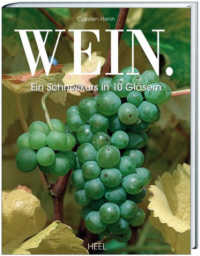 Again, we are dealing with a new publication for wine beginners. According to the text on the back, the book is addressed to "occasional connoisseurs who have not yet dealt intensively with the topic of wine". Right at the beginning, Carsten Henn goes into full confrontation with more committed wine connoisseurs, when he claims that above 10 euros you can hardly taste the difference to more expensive wines, and above 20 euros a connection between price and taste is more related to faith than really to taste. Well ...
Again, we are dealing with a new publication for wine beginners. According to the text on the back, the book is addressed to "occasional connoisseurs who have not yet dealt intensively with the topic of wine". Right at the beginning, Carsten Henn goes into full confrontation with more committed wine connoisseurs, when he claims that above 10 euros you can hardly taste the difference to more expensive wines, and above 20 euros a connection between price and taste is more related to faith than really to taste. Well ...
A few lines later, I read that the "ideal average temperature for red wine" is 12-14 degrees Celsius.
Nevertheless, let's look at the book through the eyes of the readers for whom it is intended and who, if necessary, do not put such errors on the gold scale. Henn begins with the purchase (in the supermarket!), over the introduction of useful accessories up to the accompanying mineral water. Products are mentioned concretely by name, which can be helpful for the reader, but of course it implies a very high standard of factual and objective texts. When describing four exemplary mineral water brands, however, one is reminded for a moment of the manufacturers' advertising texts.
Wine styles from "light dry white wine" to "full-bodied red wine" are then described one after the other with typical aromas, exemplary growing regions and grape varieties typical for the respective wine style. There is a great danger that the uninitiated reader will misinterpret the exemplary character of these lists. Then, for instance, the reader will think that wine from the Nahe region or a Riesling or a Pinot Noir is usually "light" and that predominantly "white bouquet wines" come from Rheinhessen.
For each wine, there is a concrete wine recommendation with page-sized bottle illustrations. Here, more attention was paid to the distribution of the respective brand than to quality, which is understandable in view of the target group. But why the texts have to remind more of advertising texts than of serious wine descriptions remains incomprehensible.
Finally, the reader is again given many practical tips. The hints are concrete and usually quite useful; but here, too, there are mistakes which - again from the point of view of the more committed wine lover - are not necessary. According to Henn, for instance, the danger of cork taint can be reduced by storing the wine standing upright. However, since a cork taint is not caused by storage but is present or absent from the moment of bottling, storage probably has no influence on this.
Also the very uncritical enumeration of the positive effects of the wine consumption on the health, seems to me much too undifferentiated. Hardly a word about the dangers, but a mention of all the alleged positive effects, as these are "established" by various "studies" again and again. In this form, I accept this in advertising brochures of wine-growing associations, but not in a book written with journalistic distance and critical examination of the topic. The product photo of a generic aspirin with product packaging shown in a promotionally effective way as a recommendation against the "hangover afterwards" suggests that the photo editors either made it too easy for themselves here or possibly ... But I don't express this suspicion here, although it accompanied me through the whole book.
Conclusion: On the whole, useful information for beginners. No "beating around the bush", but practical information. However, the many points of criticism and the overall impression unfortunately lead to the recommendation to rather reach for other entry-level guides.
Carsten Henn
Wine - A crash course in 10 glasses
96 pages
Price: 14,95 Euro
More info at Amazon